case study education in china and japan pdfw
Case Study
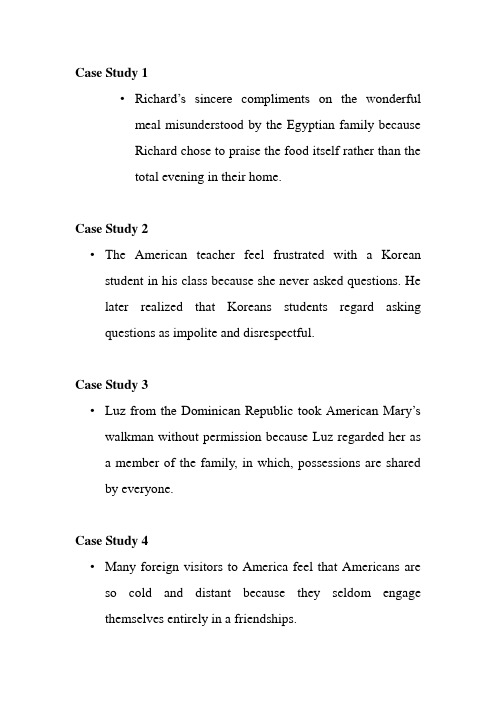
Case Study 1•Richard’s sincere compliments on the wonderful meal misunderstood by the Egyptian family becauseRichard chose to praise the food itself rather than thetotal evening in their home.Case Study 2•The American teacher feel frustrated with a Korean student in his class because she never asked questions. He later realized that Koreans students regard asking questions as impolite and disrespectful.Case Study 3•Luz from the Dominican Republic took American Mary’s walkman without permission because Luz regarded her asa member of the family, in which, possessions are sharedby everyone.Case Study 4•Many foreign visitors to America feel that Americans are so cold and distant because they seldom engage themselves entirely in a friendships.Case Study 5• A Canadian tourist offered his Chinese guide a bottle of beer, but the guide refused even though he liked beer very much. The Chinese guide was just being modest and polite and expected to refuse twice before finally accepting the beer on the third offer.Case Study 6•Litz was surprised her visiting Chinese mother-in-law decided to leave only two days afterher arrival in Finland.•This was because the mother of her Chinese husband overheard her ask him: “how long is she going tostay?” Her husband’s mother believed she was nolonger welcome.Case Study 7•Japanese foreign student was embarrassed when her college friends brought over some old furniture and appliances to help her be more comfortable in her newhome. She was embarrassed because she believed it would be rude and impolite not to offer them gifts in returnCase Study 8•Amy and her family live in America. They are Chinese. On Christmas Eve, Amy invited her American friend and family to have dinner with them in their home. Amy’s mother cooked them Chinese dishes instead of traditional American Christmas food and her family behaved as normal when eating their food. Her mother taught her that she should be proud of her cultural differences. The only shame is to have shameCase Study 9• A young Canadian executive surprised to discover that a previous business arrangement made by both him and his young Japanese counterpart had been rejected by his retired grandfather at a meeting.•The young Japanese chairman simply nodded and accepted his gra ndfather’s comments because he respected his grandfather’s authority and was loyal and obedient to him.Case Study 10• A young Japanese general manager felt extremely surprised when Mr. Legrand, a French engineerworking for his company, decided not to accept aposition in the Middle East which offered promotionand more money.•What surprised him was that Mr. Legrand chose to talk to his wife first before making his decision.•Japanese men seldom discuss this matter with their wives.Case Study 11• A Japanese girl felt shocked and insulted when the shop assistant did not apologize for the broken lampshe had bought.•She was shocked by his behavior because in Japan, shop assistants would treat customers like gods andwould be very apologetic.Case Study 12• A welcome dinner held by one of Canada’s leading banksfor the Chinese delegation was not a success because the Chinese did not receive any welcome speeches or toasts to good health during the meal.Case Study 13•The Americans did not recognize the Japanese government’s intention to consider their ultimatum of surrender because the translated word “Mokusatsu” had two meanings. The first meant “to take no notice of” and the second meant “to consider”. The Americans unfortunately believed that their ultimatum had been rejected.Case Study 14•The translator had a problem on how to translate the names “Yang” and “Liu” in one of Mao’s poems.•The general rule here is that it is better not to translate people’s names, road names, city names and so on.Case Study 15•The translated text from a Chinese travel brochure about the Dragon Boat Festival unsuitable for a foreign visitor because the text assumed the reader was already familiar with Chinese history and culture.•The text did not provide any historical background information to the event nor give the visitor any important travel information.Case Study 16•When we compare different translations of the same text we can discover the cultural gaps and learn waysto bridge those gaps for better communication.Case Study 17•On a flight from Japan to Hong Kong, Chinese businessman Chu Hon-fai felt uncomfortable with the American businessman’s approach to using first name terms as friendly gesture and by calling him by his Chinese first name. He’s never called Hon-fai at home. He thinks the American would be rather insensitive to Chinesecustoms.Case Study 18•An American was a dinner guest in a Pakistani household.He had a delicious meal and was no longer hungry. The hostess asked him several times if he would like more curry as his plate was empty. She continued to offer him more because she believed that he only refused more curry out of politeness and that he would accept more on the third or fourth offer.Case Study 19•An visiting Canadian professor Ron Kelly give so much praise that seemed irrelevant before finally mentioning his difficult problem with his Chinese hosts in Sichuan. This was because he realised that Chinese people prefer harmony and put emphasis on saving face and establishing good relations. He learned that this way to communicate his message was more productive in China.Case Study 20•Letters of Request written in Chinese are different fromthose written in English because they are usually indirect and give reasons before making the request.。
国内学习优点英文作文
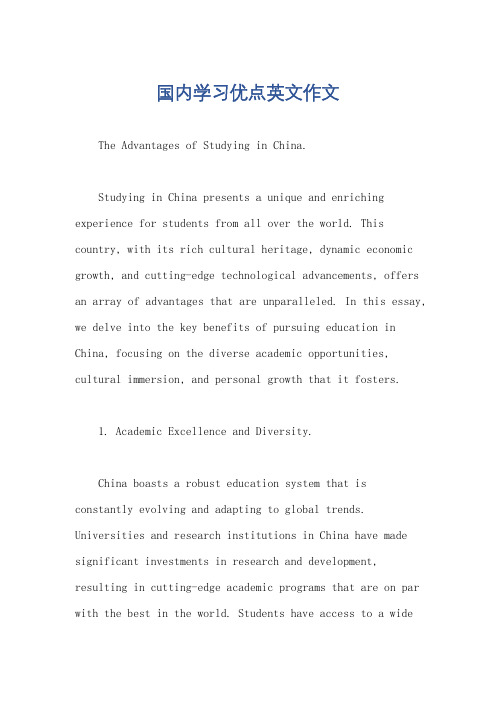
国内学习优点英文作文The Advantages of Studying in China.Studying in China presents a unique and enriching experience for students from all over the world. This country, with its rich cultural heritage, dynamic economic growth, and cutting-edge technological advancements, offers an array of advantages that are unparalleled. In this essay, we delve into the key benefits of pursuing education in China, focusing on the diverse academic opportunities, cultural immersion, and personal growth that it fosters.1. Academic Excellence and Diversity.China boasts a robust education system that isconstantly evolving and adapting to global trends. Universities and research institutions in China have made significant investments in research and development, resulting in cutting-edge academic programs that are on par with the best in the world. Students have access to a widerange of courses and specializations, covering various fields from traditional humanities to modern sciences.Moreover, the academic environment in China is incredibly diverse. With students coming from diverse cultural backgrounds, it fosters a global perspective that broadens one's understanding and appreciation of different viewpoints. This diversity also encourages open discussion and critical thinking, preparing students for the challenges of a globalized world.2. Cultural Immersion and Language Skills.Studying in China provides an excellent opportunity to immerse oneself in the rich and vibrant culture of this ancient nation. From the bustling cities to the serene countryside, China offers a unique blend of tradition and modernity. Students can explore the country's rich history, art, music, and cuisine, gaining insights into the values and way of life of the Chinese people.Additionally, learning the Chinese language is aninvaluable skill. Chinese is one of the most spoken languages in the world, and proficiency in it can open up a wide range of career opportunities, especially in international businesses and organizations. Studying in China provides an ideal environment to master the language, as students are constantly surrounded by it.3. Personal Growth and Development.Studying abroad is a transformative experience that helps individuals grow both personally and professionally. Living in a new country, navigating its culture and challenges, and interacting with people from different backgrounds, promotes independence, adaptability, and resilience. These skills are crucial for success in today's interconnected world.Moreover, the rigorous academic environment in China fosters critical thinking, problem-solving, and teamwork skills. Students are encouraged to think outside the box,挑战 traditional paradigms, and collaborate with peers from diverse backgrounds to achieve common goals. This kind ofenvironment prepares students for the challenges and opportunities of the future.4. Career Prospects and Networking.Studying in China also offers excellent career prospects. With the country's rapidly growing economy and expanding industries, there are ample job opportunities for graduates. The skills and knowledge acquired during their studies, coupled with the language proficiency and cultural understanding, make them highly competitive in the job market.Additionally, studying in China provides an excellent platform for networking. Students have the opportunity to meet and interact with peers, professors, and industry experts from around the world. These connections can lead to valuable mentorships, internships, and job opportunities in the future.In conclusion, studying in China presents a unique and enriching experience that offers a range of advantages.From academic excellence and diversity to cultural immersion and personal growth, it is an opportunity that fosters intellectual curiosity, cultural understanding, and personal development. As the world becomes increasingly interconnected, the skills and insights gained from studying in China will be invaluable assets for students in their future careers and lives.。
case study 英文格式
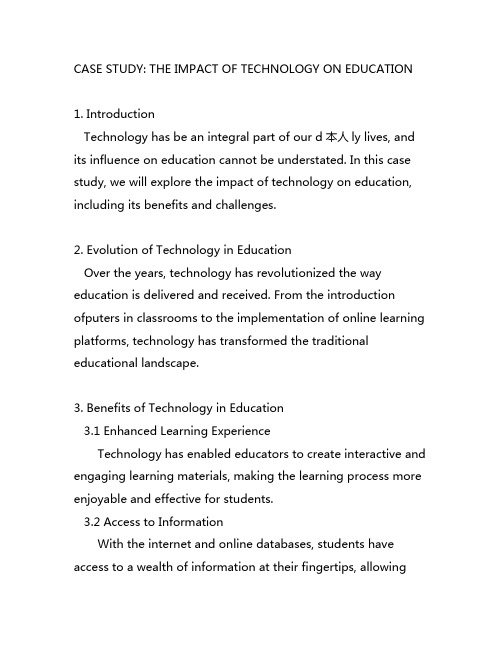
CASE STUDY: THE IMPACT OF TECHNOLOGY ON EDUCATION1. IntroductionTechnology has be an integral part of our d本人ly lives, and its influence on education cannot be understated. In this case study, we will explore the impact of technology on education, including its benefits and challenges.2. Evolution of Technology in EducationOver the years, technology has revolutionized the way education is delivered and received. From the introduction ofputers in classrooms to the implementation of online learning platforms, technology has transformed the traditional educational landscape.3. Benefits of Technology in Education3.1 Enhanced Learning ExperienceTechnology has enabled educators to create interactive and engaging learning materials, making the learning process more enjoyable and effective for students.3.2 Access to InformationWith the internet and online databases, students have access to a wealth of information at their fingertips, allowingthem to explore beyond the confines of the traditional classroom.3.3 Personalized LearningTechnology has made it possible for educators to t本人lor learning materials to individual student needs, providing a personalized learning experience for each student.4. Challenges of Technology in Education4.1 Technology-DependentThe overreliance on technology in education can lead to a lack of critical thinking and problem-solving skills in students.4.2 Privacy and Security ConcernsThe use of technology in education r本人ses concerns about student privacy and data security, especially in online learning environments.4.3 Technology AccessibilityNot all students have equal access to technology, creating a digital divide that may hinder their learning opportunities.5. Case Studies5.1 Flipped Classroom ModelThe flipped classroom model utilizes technology to deliver instructional content outside of the classroom, allowing formore active and engaged learning during class time.Case Study: A high school in Florida implemented the flipped classroom model and saw a significant improvement in student engagement and academic performance.5.2 Online Learning PlatformsOnline learning platforms provide students with the flexibility to learn at their own pace and convenience, breaking down geographical barriers to education.Case Study: A university in the United Kingdom adopted online learning platforms and witnessed an increase in enrollment and student satisfaction.6. Rmendations for Future Integration of Technology in Education6.1 Digital Literacy Tr本人ningEducators should receive tr本人ning on how to effectively integrate technology into their teaching practices, ensuring that students develop essential digital literacy skills.6.2 Equity in Access to TechnologyEfforts should be made to bridge the digital divide and ensure that all students have equal access to technology for learning purposes.6.3 Data Privacy and Security MeasuresEducational institutions should prioritize the implementation of robust data privacy and security measures to protect student information in digital learning environments.7. ConclusionAs technology continues to advance, its impact on education will only grow in significance. By understanding the benefits and challenges of technology in education, we can work towards harnessing its potential to provide quality and equitable education for all.。
英语论文案例分析-casestudy
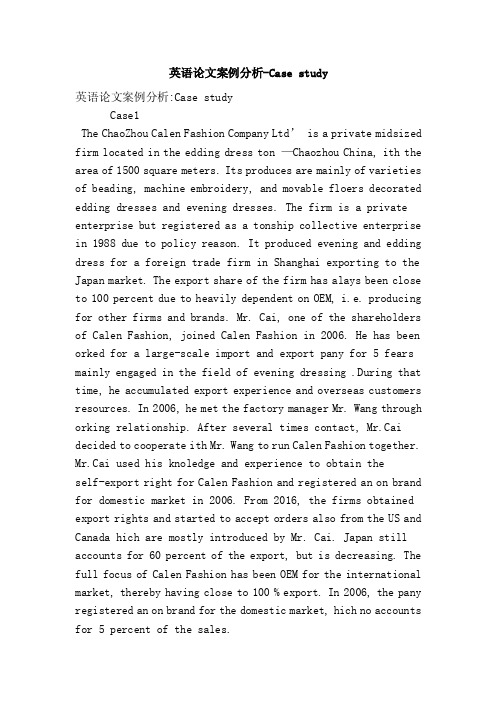
英语论文案例分析-Case study英语论文案例分析:Case studyCase1The ChaoZhou Calen Fashion Company Ltd’ is a private midsized firm located in the edding dress ton —Chaozhou China, ith the area of 1500 square meters. Its produces are mainly of varieties of beading, machine embroidery, and movable floers decorated edding dresses and evening dresses. The firm is a private enterprise but registered as a tonship collective enterprise in 1988 due to policy reason. It produced evening and edding dress for a foreign trade firm in Shanghai exporting to the Japan market. The export share of the firm has alays been close to 100 percent due to heavily dependent on OEM, i.e. producing for other firms and brands. Mr. Cai, one of the shareholders of Calen Fashion, joined Calen Fashion in 2006. He has been orked for a large-scale import and export pany for 5 fears mainly engaged in the field of evening dressing .During that time, he accumulated export experience and overseas customers resources. In 2006, he met the factory manager Mr. Wang through orking relationship. After several times contact, Mr.Cai decided to cooperate ith Mr. Wang to run Calen Fashion together. Mr.Cai used his knoledge and experience to obtain theself-export right for Calen Fashion and registered an on brand for domestic market in 2006. From 2016, the firms obtained export rights and started to accept orders also from the US and Canada hich are mostly introduced by Mr. Cai. Japan still accounts for 60 percent of the export, but is decreasing. The full focus of Calen Fashion has been OEM for the international market, thereby having close to 100 % export. In 2006, the pany registered an on brand for the domestic market, hich no accounts for 5 percent of the sales.Case2Skyline Architecture FirmThe Skyline Architecture Firm is a private midsized architecture design firm located in Beijing. The firm as established in 2003, firstly undertaking project design and urban planning for domestic realty panies. According to Chinese construction regulation, foreign architecture pany ho involved in construction project in China should choose a Chinese architecture firm as a coordinator. From the beginning, through business and personal connections, the firm got many opportunities to ork ith foreign design firms in China’s project. In 2006, the firm started the first overseas project in Qatar, cooperated ith Chinese Construction Company to provide the conceptual design for Qatar clients. From then on, skyline architecture firm try to engage in international architecture petition to explore international market. Hoever, the main customer is still in China. In 2016, through an old business partner, ho orks as the project manager in a Vietnam realty pany, skyline architecture firm obtained their second overseas project. Until 2016, the firm’s overseas turnover accountfor 5% of total revenue.Mr. Chen, the intervieee, is a co-founder of the firm. He has been orked for one of the biggest state oned Architecture Design Research Group. The other partner, Mr. Cui, has been orked in Hong Kong for 5years. They set up skyline in 2003 and focused on cater to domestic realty pany. Mr. Chen said most of the ne customers introduced by business netork.Case3The ‘Shunyi Jiahua Ganment Company Ltd’ is a tonship garment process factory located in Beijing. The pany as established in 1998 and is producing apparel of cotton, ool, silk, etc., e.g.leisure shirts. The firm as established in 1998 and until 2001 it as a tonship enterprise attached to Dahua Garment Company Ltd., hich is one of the biggest state oned garment factories in Beijing. Dahua Ganment subcontracted its foreign orders to cooperative process factories, Jiahua Ganment as one of them. In 2001, China abolished the export a system gradually since the entry in the World Trade Organization . Dahua start to lose its advantage because the pany used to get export a as a state oned enterprise from Chinatex Corporation, hich is alarge-scale state-oned group corporation engaging production and trade of ra materials, textiles and garments. Under the circumstances, Jiahua started to seek orders from other trade or agent panies to make up the shortage order from Dahua. In 2006, Jiahua separated from Dahua Garment officially and kept on OEM for the international market. The export share of the firm has alays been to 100 percent by indirect export. Their products mainly for European clothing brand.。
《经济学人》中英对照
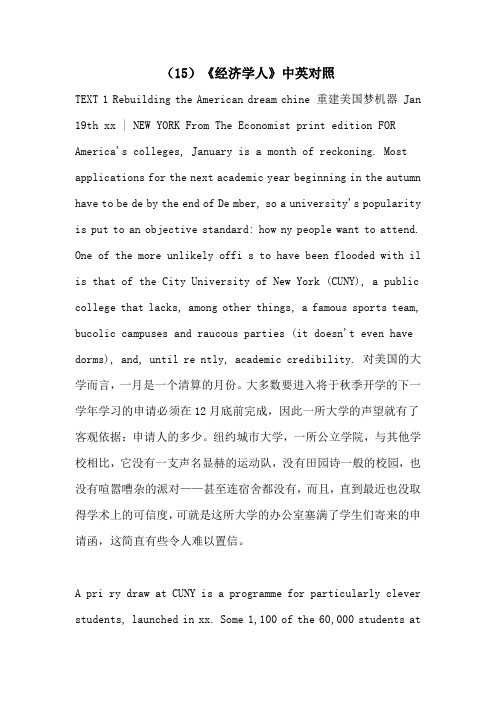
(15)《经济学人》中英对照TEXT 1 Rebuilding the American dream chine 重建美国梦机器 Jan 19th xx | NEW YORK From The Economist print edition FOR America's colleges, January is a month of reckoning. Most applications for the next academic year beginning in the autumn have to be de by the end of De mber, so a university's popularity is put to an objective standard: how ny people want to attend. One of the more unlikely offi s to have been flooded with il is that of the City University of New York (CUNY), a public college that lacks, among other things, a famous sports team, bucolic campuses and raucous parties (it doesn't even have dorms), and, until re ntly, academic credibility. 对美国的大学而言,一月是一个清算的月份。
大多数要进入将于秋季开学的下一学年学习的申请必须在12月底前完成,因此一所大学的声望就有了客观依据:申请人的多少。
纽约城市大学,一所公立学院,与其他学校相比,它没有一支声名显赫的运动队,没有田园诗一般的校园,也没有喧嚣嘈杂的派对——甚至连宿舍都没有,而且,直到最近也没取得学术上的可信度,可就是这所大学的办公室塞满了学生们寄来的申请函,这简直有些令人难以置信。
2Unit 2 Case Study

Case Study
Case 5 (Cultural differences)
Tips: Chinese people tend to accept an offer at a second or a third time in order to be polite.
North American rules set that you do not push alcoholic beverages on anyone.
7. Did you buy her a rose? b: I bought her a flower. (I didn’t buy her a rose)
Elements of Communication Matching Task
2. Good morning. Do you have anything to treat complete loss of voice?
f:Good morning, sir. What can I do for you today? (We don’t have anything to treat complete loss of voice)
Elements of Communication Matching Task
5. Would you like a cocktail? It’s my invention. i:Well, mmm uh it’s not that we don’t drink.
(I’m a bit dubious about drinking that cocktail)
Elements of Communication Matching Task
6. Are you going to Steve’s barbecue? h: It’s an outdoor party . (I’m not going to it)
雅思阅读case study
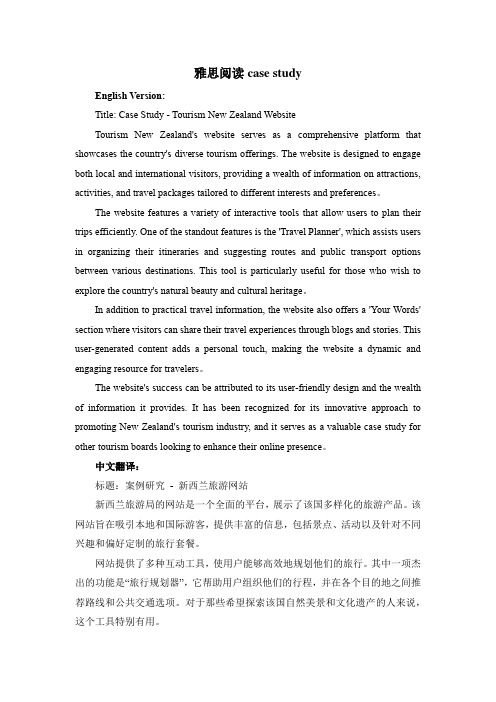
雅思阅读case studyEnglish Version:Title: Case Study - Tourism New Zealand WebsiteTourism New Zealand's website serves as a comprehensive platform that showcases the country's diverse tourism offerings. The website is designed to engage both local and international visitors, providing a wealth of information on attractions, activities, and travel packages tailored to different interests and preferences。
The website features a variety of interactive tools that allow users to plan their trips efficiently. One of the standout features is the 'Travel Planner', which assists users in organizing their itineraries and suggesting routes and public transport options between various destinations. This tool is particularly useful for those who wish to explore the country's natural beauty and cultural heritage。
留学和国内读大学区别英语作文
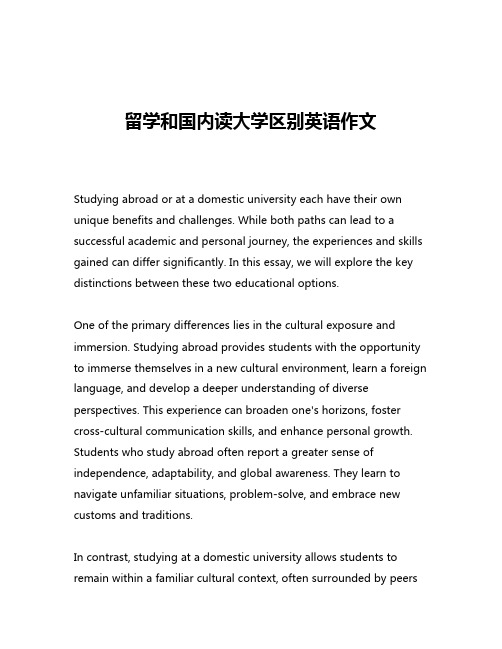
留学和国内读大学区别英语作文Studying abroad or at a domestic university each have their own unique benefits and challenges. While both paths can lead to a successful academic and personal journey, the experiences and skills gained can differ significantly. In this essay, we will explore the key distinctions between these two educational options.One of the primary differences lies in the cultural exposure and immersion. Studying abroad provides students with the opportunity to immerse themselves in a new cultural environment, learn a foreign language, and develop a deeper understanding of diverse perspectives. This experience can broaden one's horizons, foster cross-cultural communication skills, and enhance personal growth. Students who study abroad often report a greater sense of independence, adaptability, and global awareness. They learn to navigate unfamiliar situations, problem-solve, and embrace new customs and traditions.In contrast, studying at a domestic university allows students to remain within a familiar cultural context, often surrounded by peersand support systems they have known for years. This can provide a sense of comfort and stability, which can be particularly beneficial for those who are not yet ready to venture into an entirely new cultural setting. Domestic universities also often have well-established support systems, such as academic advisors, career services, and student organizations, that can help students navigate their academic journey more seamlessly.Another key difference lies in the academic environment and curriculum. Studying abroad can expose students to different educational systems, teaching styles, and course offerings. This can be both challenging and enriching, as students are required to adapt to new learning approaches and may have access to specialized programs or electives not available at their home institutions. The exposure to diverse academic perspectives can broaden students' intellectual horizons and foster critical thinking skills.On the other hand, studying at a domestic university often provides a more familiar academic structure, with well-established degree programs and course sequences. This can be particularly beneficial for students who thrive in a more structured environment and prefer the comfort of a known academic system. Domestic universities may also offer more comprehensive support services, such as tutoring, writing centers, and academic support programs, that can help students succeed in their studies.In terms of personal growth and development, both studying abroad and studying at a domestic university can offer unique opportunities. Studying abroad can challenge students to step out of their comfort zones, navigate unfamiliar situations, and develop a greater sense of independence and self-reliance. This experience can foster personal growth, adaptability, and the ability to navigate diverse cultural contexts.Conversely, studying at a domestic university can provide a more stable and supportive environment for personal development. Students may have the opportunity to build stronger relationships with peers, participate in campus activities, and engage in extracurricular pursuits that can contribute to their overall well-being and personal growth.Moreover, the financial implications of studying abroad versus studying at a domestic university can be a significant factor to consider. Studying abroad can often be more expensive, with additional costs associated with international travel, housing, and living expenses. However, many universities and study abroad programs offer financial aid and scholarship opportunities to help offset these costs. Studying at a domestic university, on the other hand, may be more affordable, particularly for students who qualify for in-state tuition or have access to local scholarships and financialaid.In conclusion, the decision to study abroad or at a domestic university is a highly personal one, and the choice ultimately depends on an individual's academic, personal, and financial goals. Both options offer unique opportunities for growth and development, and the experience can have a lasting impact on a student's future. Ultimately, the choice should be made after careful consideration of one's priorities, interests, and the resources available to support the educational journey.。
中美学校教育比较研究英语作文
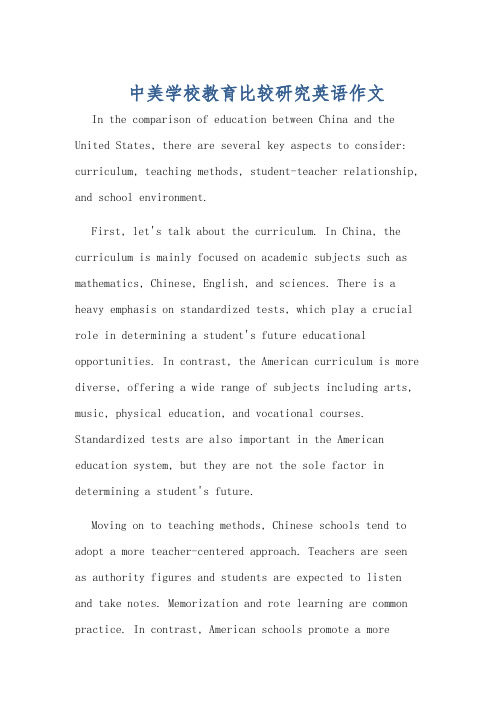
中美学校教育比较研究英语作文In the comparison of education between China and the United States, there are several key aspects to consider: curriculum, teaching methods, student-teacher relationship, and school environment.First, let's talk about the curriculum. In China, the curriculum is mainly focused on academic subjects such as mathematics, Chinese, English, and sciences. There is a heavy emphasis on standardized tests, which play a crucial role in determining a student's future educational opportunities. In contrast, the American curriculum is more diverse, offering a wide range of subjects including arts, music, physical education, and vocational courses. Standardized tests are also important in the American education system, but they are not the sole factor in determining a student's future.Moving on to teaching methods, Chinese schools tend to adopt a more teacher-centered approach. Teachers are seen as authority figures and students are expected to listen and take notes. Memorization and rote learning are common practice. In contrast, American schools promote a morestudent-centered approach, encouraging critical thinking, creativity, and active participation. Students are encouraged to ask questions, engage in discussions, and work collaboratively.The student-teacher relationship also differs between the two countries. In China, there is a strong emphasis on respect and discipline towards teachers. Teachers are seen as mentors and figures of authority. In the United States, the relationship is more informal, with teachers often being seen as facilitators and mentors. There is an emphasis on building a positive and supportive relationship between students and teachers.Lastly, the school environment in China and the United States is quite different. Chinese schools often havelarger class sizes, with a focus on maintaining discipline and order. The school day is longer, and students often have a significant amount of homework and extracurricular activities. In the United States, class sizes are typically smaller, allowing for more individualized attention and student interaction. The school day is shorter, and thereis less emphasis on homework and more on extracurricular activities and social development.总结起来,中美教育在课程设置、教学方法、师生关系和校园环境等方面存在着明显的差异。
中美法学教育的异同英语作文
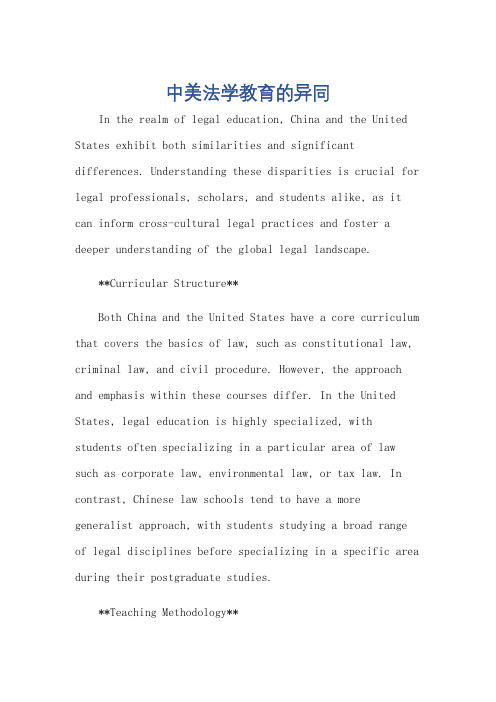
中美法学教育的异同In the realm of legal education, China and the United States exhibit both similarities and significant differences. Understanding these disparities is crucial for legal professionals, scholars, and students alike, as it can inform cross-cultural legal practices and foster a deeper understanding of the global legal landscape.**Curricular Structure**Both China and the United States have a core curriculum that covers the basics of law, such as constitutional law, criminal law, and civil procedure. However, the approach and emphasis within these courses differ. In the United States, legal education is highly specialized, with students often specializing in a particular area of law such as corporate law, environmental law, or tax law. In contrast, Chinese law schools tend to have a moregeneralist approach, with students studying a broad range of legal disciplines before specializing in a specific area during their postgraduate studies.**Teaching Methodology**In terms of teaching methodology, American law schools are known for their interactive and participatory classrooms. The "Socratic method," in which professors pose hypothetical legal scenarios and students are expected to analyze and debate the issues, is a common teaching technique. In China, the traditional lecture format isstill predominant, with professors delivering lectures and students taking notes. However, there has been a growing trend towards more interactive teaching methods in recent years, as law schools seek to emulate the American model.**Legal Research and Scholarship**American law schools place a strong emphasis on legal research and scholarship. Faculty members are expected to publish regularly in peer-reviewed journals, and students are often required to conduct independent research projects. In China, legal research and scholarship are also valued,but the focus is more on applied research that addressesreal-world legal issues rather than theoretical explorations.**Legal Culture and Ethics**The legal cultures and ethical standards of China and the United States also differ. In the United States, legal professionals are highly regarded for their expertise and objectivity. Lawyers are expected to uphold strict ethical standards and prioritize the interests of their clients above all else. In China, legal professionals are also expected to uphold high ethical standards, but there is a stronger emphasis on social harmony and stability, which can sometimes influence legal decisions.**Conclusion**In conclusion, while there are many similarities between Chinese and American legal education, there are also significant differences in curricular structure, teaching methodology, legal research and scholarship, and legal culture and ethics. Understanding these disparities is crucial for legal professionals who hope to operate effectively in both cultures. By embracing the strengths of both systems and adapting to the unique challenges of each, legal educators and practitioners can foster a more globalized and inclusive legal community.**中美法学教育的异同**中美法学教育在多个方面展现出共同点和差异性。
我建议加入汉语课程英语作文理由
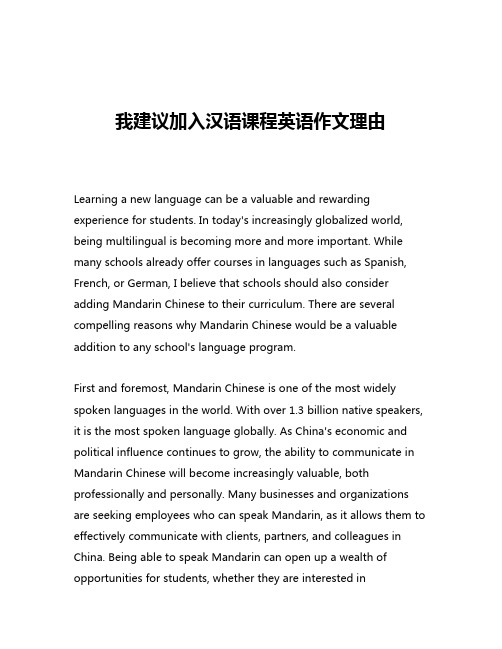
我建议加入汉语课程英语作文理由Learning a new language can be a valuable and rewarding experience for students. In today's increasingly globalized world, being multilingual is becoming more and more important. While many schools already offer courses in languages such as Spanish, French, or German, I believe that schools should also consider adding Mandarin Chinese to their curriculum. There are several compelling reasons why Mandarin Chinese would be a valuable addition to any school's language program.First and foremost, Mandarin Chinese is one of the most widely spoken languages in the world. With over 1.3 billion native speakers, it is the most spoken language globally. As China's economic and political influence continues to grow, the ability to communicate in Mandarin Chinese will become increasingly valuable, both professionally and personally. Many businesses and organizations are seeking employees who can speak Mandarin, as it allows them to effectively communicate with clients, partners, and colleagues in China. Being able to speak Mandarin can open up a wealth of opportunities for students, whether they are interested ininternational business, diplomacy, or simply traveling and immersing themselves in Chinese culture.Moreover, learning Mandarin Chinese can provide students with a unique cognitive and cultural experience. The Chinese writing system, with its thousands of complex characters, is vastly different from the alphabetic systems used in many Western languages. Mastering the writing system requires a deep understanding of the language's structure and the ability to recognize and recall a large number of characters. This process can enhance students' problem-solving skills, memory, and attention to detail – all valuable assets in any academic or professional endeavor.In addition, learning Mandarin Chinese can also broaden students' cultural horizons. The Chinese language is deeply rooted in a rich and ancient civilization, with a long history of literature, art, and philosophy. By studying Mandarin, students can gain a deeper appreciation for Chinese culture and traditions, which can foster greater cross-cultural understanding and respect. This cultural exposure can be particularly valuable in an increasingly interconnected world, where the ability to navigate and appreciate diverse cultural perspectives is becoming increasingly important.Furthermore, adding Mandarin Chinese courses to a school's curriculum can also have practical benefits for the institution itself.As more and more families recognize the value of multilingualism, offering Mandarin Chinese as a language option can make a school more attractive to prospective students and their families. This, in turn, can lead to increased enrollment and a more diverse student body, which can enhance the overall educational experience for all students.Additionally, teaching Mandarin Chinese can also provide professional development opportunities for teachers. Schools can invest in training and supporting their faculty to become proficient in Mandarin, which can not only improve the quality of instruction but also open up new career paths for teachers. This can help to attract and retain talented educators, further strengthening the school's academic programs.Finally, the inclusion of Mandarin Chinese in a school's curriculum can also have broader societal benefits. By exposing students to this important language and culture, schools can play a role in fostering greater cross-cultural understanding and cooperation, which can have far-reaching implications for the future. As the world becomes increasingly interconnected, the ability to communicate effectively across linguistic and cultural boundaries will be essential for addressing global challenges and promoting peace and prosperity.In conclusion, there are numerous compelling reasons why schoolsshould consider adding Mandarin Chinese courses to their curriculum. From the practical benefits of increased job opportunities and cultural exposure to the cognitive and academic advantages of learning a complex language, the inclusion of Mandarin Chinese can be a valuable investment in the education and development of students. As the world continues to evolve, the ability to communicate in Mandarin Chinese will become an increasingly valuable asset, and schools that recognize this and take steps to offer this language option will be well-positioned to prepare their students for success in the 21st century.。
关于中国成为留学的目的地英语作文
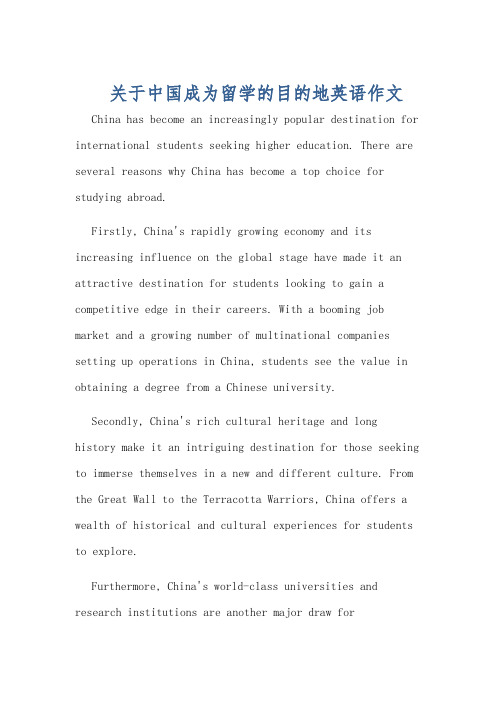
关于中国成为留学的目的地英语作文China has become an increasingly popular destination for international students seeking higher education. There are several reasons why China has become a top choice for studying abroad.Firstly, China's rapidly growing economy and its increasing influence on the global stage have made it an attractive destination for students looking to gain a competitive edge in their careers. With a booming job market and a growing number of multinational companies setting up operations in China, students see the value in obtaining a degree from a Chinese university.Secondly, China's rich cultural heritage and longhistory make it an intriguing destination for those seeking to immerse themselves in a new and different culture. From the Great Wall to the Terracotta Warriors, China offers a wealth of historical and cultural experiences for students to explore.Furthermore, China's world-class universities and research institutions are another major draw forinternational students. With a focus on innovation and cutting-edge research, Chinese universities are attracting top talent from around the world. The opportunity to study alongside some of the brightest minds in the world is a major incentive for many students considering China astheir study abroad destination.In addition, the affordability of education in China is also a significant factor. Compared to many Western countries, the cost of tuition and living expenses in China is relatively low, making it an attractive option for students looking to obtain a quality education without breaking the bank.Moreover, the Chinese government has been actively promoting internationalization in higher education, with initiatives such as the "Study in China" program and scholarships for international students. These efforts have helped to raise the profile of Chinese universities and make them more accessible to students from around the world.In conclusion, China's growing economy, rich culture,top-tier universities, affordability, and governmentsupport have all contributed to making it a populardestination for international students. As China continues to rise as a global power, its appeal as a study abroad destination is likely to grow even further in the coming years.中国已成为越来越受国际学生青睐的留学目的地。
中国教育的优缺点英语作文

中国教育的优缺点英语作文China's Education System: Strengths and WeaknessesChina's education system is one of the most extensive and complex in the world, with a long history and a unique set of characteristics. As the world's most populous country, China's approach to education has had a significant impact on its economic and social development. In this essay, we will explore the strengths and weaknesses of China's education system.One of the primary strengths of China's education system is its emphasis on academic excellence. Chinese students are known for their exceptional performance in subjects like mathematics, science, and engineering, often outperforming their peers from other countries in international assessments. This focus on academic achievement is deeply rooted in the country's cultural traditions, which place a high value on education and intellectual pursuits.Another strength of the Chinese education system is its comprehensive infrastructure and resources. The government has invested heavily in building schools, universities, and educational facilities across the country, ensuring that students have access toquality education regardless of their geographic location. This has contributed to the high enrollment rates and the overall accessibility of education in China.Additionally, the Chinese education system is known for its emphasis on discipline, hard work, and perseverance. Students are expected to put in long hours of study, often with the support of their families and the broader community. This culture of diligence and dedication has been instrumental in producing a highly skilled and hardworking workforce, which has been a key driver of China's economic growth.However, the Chinese education system is not without its weaknesses. One of the primary criticisms is its overemphasis on rote learning and standardized testing. Students are often required to memorize large amounts of information and regurgitate it during exams, rather than developing critical thinking and problem-solving skills. This approach can stifle creativity and limit the ability of students to adapt to the rapidly changing demands of the modern workforce.Another weakness of the Chinese education system is its lack of flexibility and individualization. The curriculum is highly standardized, with little room for students to pursue their own interests or explore alternative learning paths. This can be particularly challenging for students with unique learning needs or those who do not fit themold of the traditional academic system.Furthermore, the intense academic pressure and the high-stakes nature of the education system in China can have negative impacts on the mental health and well-being of students. The constant pressure to excel academically can lead to high levels of stress, anxiety, and even depression among young people, which can have long-lasting consequences on their overall development and quality of life.Despite these weaknesses, it is important to acknowledge that the Chinese education system has also undergone significant reforms and improvements in recent years. The government has recognized the need to foster more creativity, critical thinking, and well-rounded development among students, and has implemented various initiatives to address these issues.For example, the introduction of more project-based learning, the incorporation of more diverse assessment methods, and the emphasis on developing soft skills like communication and teamwork have all been efforts to address the limitations of the traditional education system. Additionally, there have been increased investments in mental health support and counseling services for students, recognizing the importance of holistic student development.In conclusion, China's education system is a complex and multifaceted entity, with both strengths and weaknesses. While the focus on academic excellence and the comprehensive infrastructure have contributed to the country's economic and social progress, the overemphasis on standardized testing and the lack of flexibility have also posed significant challenges. As China continues to evolve and adapt to the changing needs of the 21st century, it will be crucial for its education system to strike a balance between academic rigor and the development of well-rounded, creative, and adaptable individuals who can thrive in the global landscape.。
RCEP_背景下东盟来华留学生培养实践探索与优化对策——以广西农业职业技术大学为例
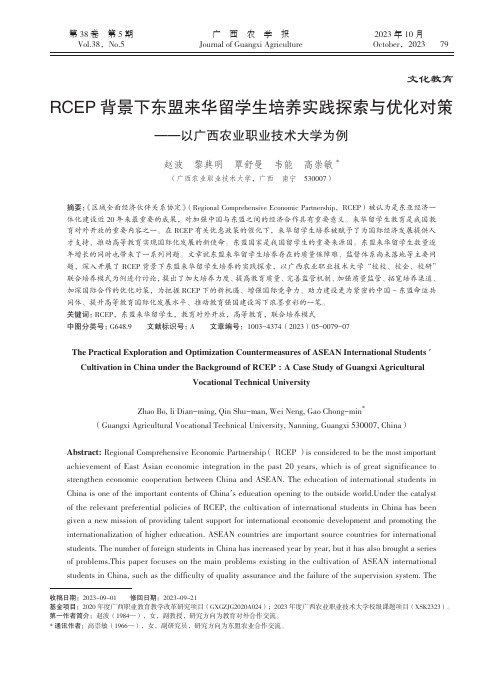
广 西 农 学 报Journal of Guangxi Agriculture 第38卷 第5期Vol.38,No.5792023年10月October,2023RCEP 背景下东盟来华留学生培养实践探索与优化对策——以广西农业职业技术大学为例赵波 黎典明 覃舒曼 韦能 高崇敏*(广西农业职业技术大学,广西 南宁 530007)摘要:《区域全面经济伙伴关系协定》(Regional Comprehensive Economic Partnership ,RCEP )被认为是东亚经济一体化建设近20年来最重要的成果,对加强中国与东盟之间的经济合作具有重要意义。
来华留学生教育是我国教育对外开放的重要内容之一。
在RCEP 有关优惠政策的催化下,来华留学生培养被赋予了为国际经济发展提供人才支持、推动高等教育实现国际化发展的新使命。
东盟国家是我国留学生的重要来源国。
东盟来华留学生数量逐年增长的同时也带来了一系列问题。
文章就东盟来华留学生培养存在的质量保障难、监督体系尚未落地等主要问题,深入开展了RCEP 背景下东盟来华留学生培养的实践探索,以广西农业职业技术大学“校校、校企、校研”联合培养模式为例进行讨论,提出了加大培养力度、提高教育质量、完善监管机制、加强质量监管、拓宽培养渠道、加深国际合作的优化对策,为把握RCEP 下的新机遇、增强国际竞争力、助力建设更为紧密的中国-东盟命运共同体、提升高等教育国际化发展水平、推动教育强国建设写下浓墨重彩的一笔。
关键词:RCEP ,东盟来华留学生,教育对外开放,高等教育,联合培养模式中图分类号:G648.9 文献标识号:A 文章编号:1003-4374(2023)05-0079-07The Practical Exploration and Optimization Countermeasures of ASEAN International Students ´ Cultivation in China under the Background of RCEP:A Case Study of Guangxi AgriculturalVocational Technical UniversityZhao Bo, li Dian-ming, Qin Shu-man, Wei Neng, Gao Chong-min *(Guangxi Agricultural Vocational Technical University, Nanning, Guangxi 530007, China )Abstract: Regional Comprehensive Economic Partnership ( RCEP )is considered to be the most important achievement of East Asian economic integration in the past 20 years, which is of great significance to strengthen economic cooperation between China and ASEAN. The education of international students in China is one of the important contents of China's education opening to the outside world.Under the catalyst of the relevant preferential policies of RCEP, the cultivation of international students in China has been given a new mission of providing talent support for international economic development and promoting the internationalization of higher education. ASEAN countries are important source countries for international students. The number of foreign students in China has increased year by year, but it has also brought a seriesof problems.This paper focuses on the main problems existing in the cultivation of ASEAN international students in China, such as the difficulty of quality assurance and the failure of the supervision system. The收稿日期:2023-09-01 修回日期:2023-09-21基金项目:2020年度广西职业教育教学改革研究项目(GXGZJG2020A024);2023年度广西农业职业技术大学校级课题项目(XSK2323)。
如何在中国做出更好的教育系统的英语作文
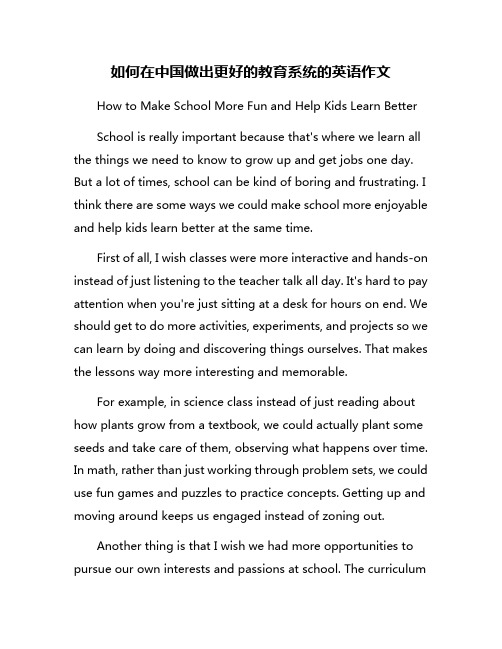
如何在中国做出更好的教育系统的英语作文How to Make School More Fun and Help Kids Learn BetterSchool is really important because that's where we learn all the things we need to know to grow up and get jobs one day. But a lot of times, school can be kind of boring and frustrating. I think there are some ways we could make school more enjoyable and help kids learn better at the same time.First of all, I wish classes were more interactive and hands-on instead of just listening to the teacher talk all day. It's hard to pay attention when you're just sitting at a desk for hours on end. We should get to do more activities, experiments, and projects so we can learn by doing and discovering things ourselves. That makes the lessons way more interesting and memorable.For example, in science class instead of just reading about how plants grow from a textbook, we could actually plant some seeds and take care of them, observing what happens over time. In math, rather than just working through problem sets, we could use fun games and puzzles to practice concepts. Getting up and moving around keeps us engaged instead of zoning out.Another thing is that I wish we had more opportunities to pursue our own interests and passions at school. The curriculumis so packed with requirements that there's hardly any time for electives or passion projects. But when we get to choose what we're learning about and decide how to approach it, suddenly the motivation is there. We'll work way harder on something we actually care about.Maybe there could be like a "Genius Hour" each week where we get to spend time exploring whatever topic or skill we want, with guidance from teachers. Or we could pick a subject we're really into and do an extended project or internship experience related to it. The more we can personalize our learning, the more engaged we'll be.School days also feel really long and drab from being stuck inside the same classrooms and routines all day, every day. It would be awesome if we could shake things up more and get out of the school building for learning sometimes. We could go on more field trips to museums, historical sites, nature reserves, and different workplaces to see how what we're studying gets applied in the real world. Or certain lessons could even be held outdoors when the weather is nice.Keeping brains active and focused is tough when we're just following the same old repetitive schedule day after day. Havinga variety of environments, experiences, and hands-on activities makes learning way more stimulating and memorable.Another issue is that a lot of classes prioritize just memorizing information to regurgitate on tests, rather than really understanding concepts. We spend so much time prepping for high-stakes exams instead of diving deeper into topics. It creates a lot of stress and pushes kids to develop surface-level knowledge that they'll just forget after the test is over.Classes should focus more on discussions, critical thinking, analysis, and applying knowledge in creative ways - not just rote memorization. That will help build more meaningful comprehension that sticks with us long-term. Tests should evaluate our true mastery of subjects through open-ended questions and projects, not just regurgitating facts and formulas.Learning styles also differ for every student. While some kids are great at sitting still and absorbing information from lectures, others might be more visual, hands-on, or kinesthetic learners who struggle in that format. Having more diversity in how material is presented and how we're assessed would give everyone a fair opportunity to shine.For instance, along with writing reports, we could get chances to do oral presentations, videos, skits, models, or artwork to demonstrate our learning sometimes. Mixing it up engages different skills and lets each student's strengths come through at least some of the time.Overall, making more space in the curriculum for passion projects, real-world learning experiences, interactive and multimedia lessons, and diversifying how we apply knowledge would make school a lot more stimulating and effective. Instead of just stuffing our heads with content, we'd get to really explore our interests and develop deeper understanding that we'll actually remember. Learning would feel more like an exciting journey of discovery rather than a arduous chore to dread each day.Of course, there's a foundational level of core subjects that everyone needs to master as a basic education. But if we could spend more time immersed in hands-on, self-directed, andreal-world applied learning within those subjects, kids would stay engaged and see the relevance of what we're studying. Instead of forcing us down a rigid path, school should be about lighting a fire of curiosity to fuel our own learning journeys.School is incredibly important, but it's not living up to its full potential to nurture passionate lifelong learners right now. With some creativity and flexibility in the curriculum and more engaging, personalized approaches, we could totally transform the student experience and get kids way more enthusiastic about building the knowledge and skills for bright futures. Having fun and being inspired should be just as prioritized as studying the fundamentals. If learning becomes more of an exciting exploration than a chore to slog through, just imagine the potential we could unlock!。
中国教育的挑战的英文作文
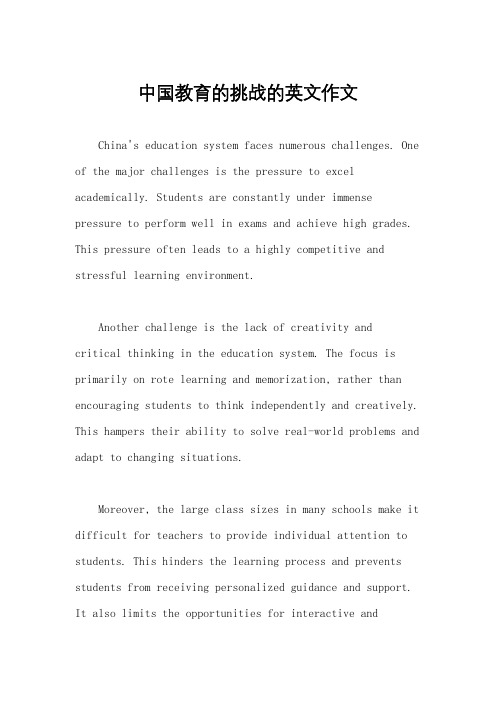
中国教育的挑战的英文作文China's education system faces numerous challenges. One of the major challenges is the pressure to excel academically. Students are constantly under immense pressure to perform well in exams and achieve high grades. This pressure often leads to a highly competitive and stressful learning environment.Another challenge is the lack of creativity andcritical thinking in the education system. The focus is primarily on rote learning and memorization, rather than encouraging students to think independently and creatively. This hampers their ability to solve real-world problems and adapt to changing situations.Moreover, the large class sizes in many schools make it difficult for teachers to provide individual attention to students. This hinders the learning process and prevents students from receiving personalized guidance and support. It also limits the opportunities for interactive andparticipatory learning experiences.Furthermore, there is a disparity in the quality of education between urban and rural areas. Urban schools often have better resources and facilities, while rural schools struggle with inadequate infrastructure and limited access to educational resources. This inequality in education opportunities creates a significant divide between students from different regions.In addition, the emphasis on academic subjects neglects the importance of holistic development. Extracurricular activities, such as sports, arts, and music, are often overlooked or given less priority. This narrow focus on academics deprives students of opportunities to explore their interests and talents in other areas.Another challenge is the lack of vocational education options. The education system primarily focuses on preparing students for university entrance exams, neglecting the need for practical skills and vocational training. This leads to a mismatch between the skillsrequired in the job market and the skills possessed by graduates.Furthermore, the traditional teaching methods and outdated curriculum fail to keep pace with the rapidly changing world. The education system needs to adapt to the demands of the 21st century, which include digital literacy, technological skills, and global awareness. Without these skills, students may struggle to compete in the global economy.Lastly, the pressure to conform to societalexpectations and follow a predetermined path in terms of career choices is another challenge. Students are often pushed towards certain professions, such as medicine or engineering, disregarding their individual interests and talents. This limits their potential and stifles their creativity.In conclusion, China's education system faces various challenges, including academic pressure, lack of creativity, large class sizes, regional disparities, neglect ofholistic development, lack of vocational education options, outdated curriculum, and societal expectations. Addressing these challenges is crucial to ensure a well-rounded and inclusive education system that prepares students for the future.。
A Comparative Study on Education System Between China and UK
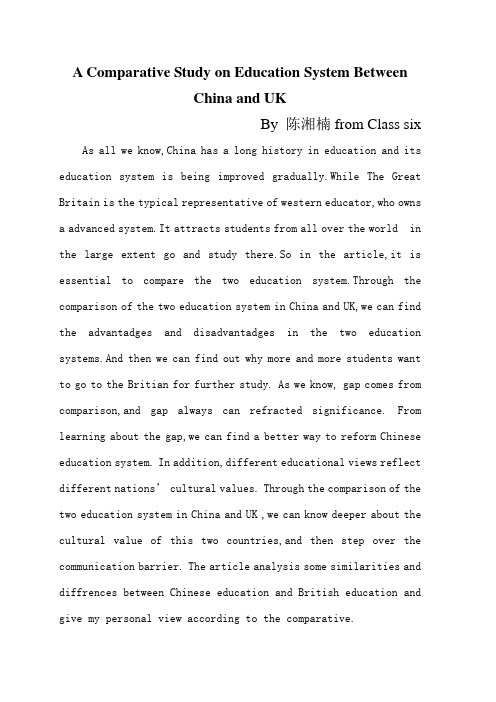
A Comparative Study on Education System BetweenChina and UKBy 陈湘楠from Class six As all we know,China has a long history in education and its education system is being improved gradually.While The Great Britain is the typical representative of western educator,who owns a advanced system.It attracts students from all over the world in the large extent go and study there.So in the article,it is essential to compare the two education system.Through the comparison of the two education system in China and UK,we can find the advantadges and disadvantadges in the two education systems.And then we can find out why more and more students want to go to the Britian for further study. As we know, gap comes from comparison,and gap always can refracted significance. From learning about the gap,we can find a better way to reform Chinese education system. In addition,different educational views reflect different nations’cultural values. Through the comparison of the two education system in China and UK ,we can know deeper about the cultural value of this two countries,and then step over the communication barrier. The article analysis some similarities and diffrences between Chinese education and British education and give my personal view according to the comparative.Both China and UK have law on compulsory education, which provide a favorable legal protection for the popularization and development of compulsory education.What is more,According to Graham David, they both have a very rigorous assessment system in the education. And teachers in China and UK have high request to their students. In addition, they both emphasize the traditional theory research and basic knowledge of the students.The students in this two cuntries have a ability to find the necessary conditions to draw the inevitable conclusion by themselves. ②Because of diffrent history, culture, traditions and economic and so on,there are many diffrences between Chinese education and British education.Firstly, According to Graham David, China has a nationwide system of public education,which includes primary schools,middle schools and universities.Nine years of education is technically compulsory for all Chinese cation in China is the responsibility of the Ministry of Education So the tutions always come from the government.Although the British education is also compulsory education,it last eleven years.Its school system is two-track system which includes course teaching and individual counseling.In addition,Britain has public schools and private schools. And the tutions are free in the public school while thosecome from the students' parents in the private school. Secondly, according to Lucky,China and UK culculate personnel in different directions. China aims to develop general education.So the Chinese schools have many subjects,such as Chinese, math, English, history, physics and so on.The Chinese students must study these subjects every day.And they must work hard that they hardly have spare time to relax themselves.So a lot of Chinese students are under great study pressure. But Britain aims to develop experts.So the students in UK have more chances to choose and stick to an elective cource to expand their knowledge and visions.And they have much more spare time to play than Chinese students.Thirdly, according to Ren zaifa ,the Chinese educational system is very simple. Most of students have to pass the college entrance examination.And then they can go to college to study a major.But in Britain, the students have many choices to study.There are many technology schools. Everybody can enter without certisfication and limeted age.Fourthly,according to Lucky, he relationship between teathers and students are also different. Teachers would like to be the friends but governors in the UK. But teachers are over-strict in China.Finally,according to Charles Cater ,the educational concept between China and UK is quite different.Chinese education focuses on textbook and pay attention to the accumulation and implants ofknowledge.It evaluates students’achievement according to score and cultivates students' strict and rigorous spirit.While British education gives priority to with practical knowledge and pays attention to the application.It culitivates tudents' spirit of confidence and independence. ①②③④From the comparison of the two education system in China and UK,it is obvious that there are a lot of differences in length of schooling,ways of teaching and keystone of education in the systems.Everything in the world has its both sides.The education either in China or in the UK has its own advantages and disadantages.Therefore it is difficult to judge which one is better just by the rate of admission.But it is previous that we can use the system in UK for reference. In this way, it could help China to improve our education system.On the one hand,we should improve the conception of education.The government should know about the purpose of education.The aim of education is to help students adapt to the society and find a good job.So the officers should understand the relationship between the government and the schools,the schools and the students.I think the new conception of education will give the students more space to think,not to learn.It is a effective way to help students master the knowledgement.On the other hand,we should improve thepopularization of education,The teachers should not restrict the students’ sense of innovation.They are ought to encourage the students to have their own idears and break through the conventional way of learning.In sum,although Chinese education system is good enough,the system in UK is better,which gives the students enough space and allowance to learn by themselves.It is the point we should use for reference.Word Cites①/lucky630@126/blog/static/13974899820114151 04318831/②/p-296797753.html③Charles Cater Higher Education For The Future Oxford: Basil Blackwell,1980④任在发,《英才教育及特点》,湖南日报,2001年。
中美教育差异对话(英文)
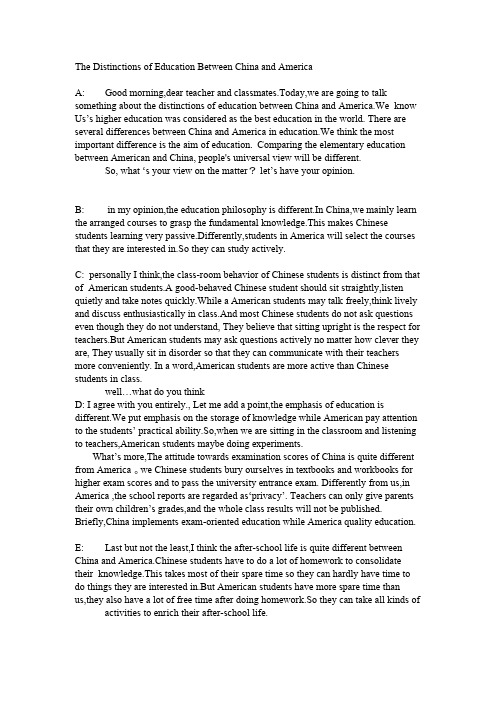
The Distinctions of Education Between China and AmericaA:Good morning,dear teacher and classmates.Today,we are going to talk something about the distinctions of education between China and America.We know Us’s higher education was considered as the best education in the world. There are several differences between China and America in education.We think the most important difference is the aim of education. Comparing the elementary education between American and China, people's universal view will be different.So, what ‘s your view on the matter? let’s have your opinion.B: in my opinion,the education philosophy is different.In China,we mainly learn the arranged courses to grasp the fundamental knowledge.This makes Chinese students learning very passive.Differently,students in America will select the courses that they are interested in.So they can study actively.C: personally I think,the class-room behavior of Chinese students is distinct from that of American students.A good-behaved Chinese student should sit straightly,listen quietly and take notes quickly.While a American students may talk freely,think lively and discuss enthusiastically in class.And most Chinese students do not ask questions even though they do not understand, They believe that sitting upright is the respect for teachers.But American students may ask questions actively no matter how clever they are, They usually sit in disorder so that they can communicate with their teachers more conveniently. In a word,American students are more active than Chinese students in class.well…what do you thinkD: I agree with you entirely., Let me add a point,the emphasis of education is different.We put emphasis on the storage of knowledge while American pay attention to the students’ practical ability.So,when we are sitting in the classroom and listening to teachers,American students maybe doing experiments.What’s more,The attitude towards examination scores of China is quite different from America 。
关于中国和美国上大学选专业的差异英语作文
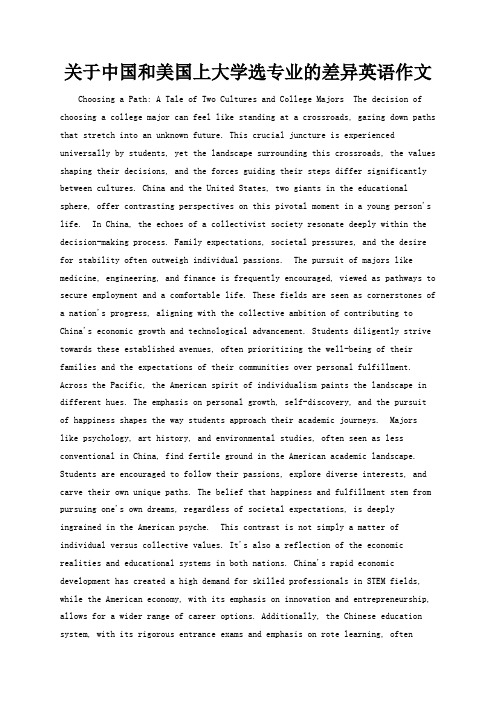
关于中国和美国上大学选专业的差异英语作文Choosing a Path: A Tale of Two Cultures and College Majors The decision of choosing a college major can feel like standing at a crossroads, gazing down paths that stretch into an unknown future. This crucial juncture is experienced universally by students, yet the landscape surrounding this crossroads, the values shaping their decisions, and the forces guiding their steps differ significantly between cultures. China and the United States, two giants in the educational sphere, offer contrasting perspectives on this pivotal moment in a young person's life. In China, the echoes of a collectivist society resonate deeply within the decision-making process. Family expectations, societal pressures, and the desire for stability often outweigh individual passions. The pursuit of majors like medicine, engineering, and finance is frequently encouraged, viewed as pathways to secure employment and a comfortable life. These fields are seen as cornerstones of a nation's progress, aligning with the collective ambition of contributing to China's economic growth and technological advancement. Students diligently strive towards these established avenues, often prioritizing the well-being of their families and the expectations of their communities over personal fulfillment. Across the Pacific, the American spirit of individualism paints the landscape in different hues. The emphasis on personal growth, self-discovery, and the pursuit of happiness shapes the way students approach their academic journeys. Majorslike psychology, art history, and environmental studies, often seen as less conventional in China, find fertile ground in the American academic landscape. Students are encouraged to follow their passions, explore diverse interests, and carve their own unique paths. The belief that happiness and fulfillment stem from pursuing one's own dreams, regardless of societal expectations, is deeply ingrained in the American psyche. This contrast is not simply a matter of individual versus collective values. It's also a reflection of the economic realities and educational systems in both nations. China's rapid economic development has created a high demand for skilled professionals in STEM fields, while the American economy, with its emphasis on innovation and entrepreneurship, allows for a wider range of career options. Additionally, the Chinese education system, with its rigorous entrance exams and emphasis on rote learning, oftenleaves less room for exploration and discovery compared to the American system, which encourages critical thinking and interdisciplinary studies. However, despite these differences, a common thread binds students from both nations: the desire for a meaningful future. Whether it's contributing to the nation's progress or pursuing personal fulfillment, the ultimate goal remains the same –to find a place in the world where they can make a difference. In recent years, both countries have seen a growing trend of students venturing beyond traditional paths, exploring interdisciplinary studies, and engaging in social entrepreneurship. This convergence suggests a future where the lines between individual aspirations and collective good may blur, creating a new generation of globally-minded individuals equipped to tackle the world's challenges with both passion and purpose.。
- 1、下载文档前请自行甄别文档内容的完整性,平台不提供额外的编辑、内容补充、找答案等附加服务。
- 2、"仅部分预览"的文档,不可在线预览部分如存在完整性等问题,可反馈申请退款(可完整预览的文档不适用该条件!)。
- 3、如文档侵犯您的权益,请联系客服反馈,我们会尽快为您处理(人工客服工作时间:9:00-18:30)。
Date: 2013/5/4Name: Mengmeng FANTitle: The system of education in China and JapanThe purpose of this case to find out the different of education between china and japan. Firstly, shown some data of central information :13.0% of government spending goes to education9.4% of government spending goes to educationFrom these data we can see the bases situation of China and Japan ,also we know the percentage of government spending goes to educationin China was quite high than Japan.EDUCATIONAL SYSTEM of CHINAChina has about 400 million students today.Chinese children typically start their formal education at age two.By the first semester of first grade, students are expected to recognize 400 Chinese characters and write 100 of them.Chinese citizens must attend school for at least nine years. According to data from China’s Ministry of Education, China has a 99% attendance rate for primary school. Under China’s “Law on Nine-Year Compulsory Education,” primary school istuition-free. However, students must pay a small tuition fee after the compulsory nine years of education during middle and high school.To boost literacy rates, the Communist party switched from “traditional” Chinese characters to a “simplified” form(using fewer strokes). Singapore also uses simplified Chinese, however, traditional characters are still used in HongKong and Taiwan.China did not have any private schools until the early 1980’s Today, there are over70,000 private schools in China of all levels and type.EDUCATIONAL SYSTEM of JAPANThe schooling years in the Japanese education system are segmented along the lines of6-3-3-4: 6 years of primary or elementary school; 3 years of middle or junior high school;3 years of high school; and4 years of university. Japan has 23,633 elementary schools, 11,134 junior high schools, 5,450 senior high schools, 995 schools for the handicapped, 702 universities, 525 junior colleges, and 14,174 kindergartens (May 2003 figures). School attendance rate for the nine years of compulsory education is 99.98%.Japanese children enter primary school from age 6. The average class size in suburban schools is between 35-40 students, though the national average had dropped to 28.4 pupils per class in 1995. 70% of teachers teach all subjects as specialist teachers are rare in elementary schools.Analysis 1school life expectancy (years) primary to secondary. totalThe primary to secondary full-time education at 2008 to 2010 the school life expectancy in Japan always high than ChinaAnaysis 2indicators : GER & NERPercentages of children in school are represented by Gross Enrolment Ratios (GER) and Net Enrolment Ratios (NER). GER is the number of pupils enrolled in a given level of education regardless of age expressed as a percentage of the population in the theoretical age group for that level of education. The GER may be greater than 100% when students younger or older than the official age for a given level of education are enrolled in that level. NER is the number of pupils in the theoretical age group who are enrolled expressed as a percentage of the same population.Participation in education of China at 2010Participation in education of Japan at 2010According to the international standard classification of education (ISCED) levelof education , from both picture we can see that the GER of China at level of primary education ( 1 level ) is high than Japan , but at the level of first stage of tertiary education and second stage of tertiary (5+6 level ) is lower than Japan what 's more , on the pre-primary education level ( 0 level ) and total level of secondary education which lower and upper ( 2+3 level ) they are quite similar . ConclusionBy the anaysis we get the consequence that in China more people can reach the basic education than Japan , but a few of people can get the tertiary education less than Japan.recommendationWhy China has poor number people who with high degree ? From my point of view , one of reason is China has a huge population , more familly have more than one children to offer. T he expenditure of education in per familly is too high so they have to give up the study when they get the basic education .To positive say that China developing very fast. It' is will be improve if the govenment can invest more money in education system.。
